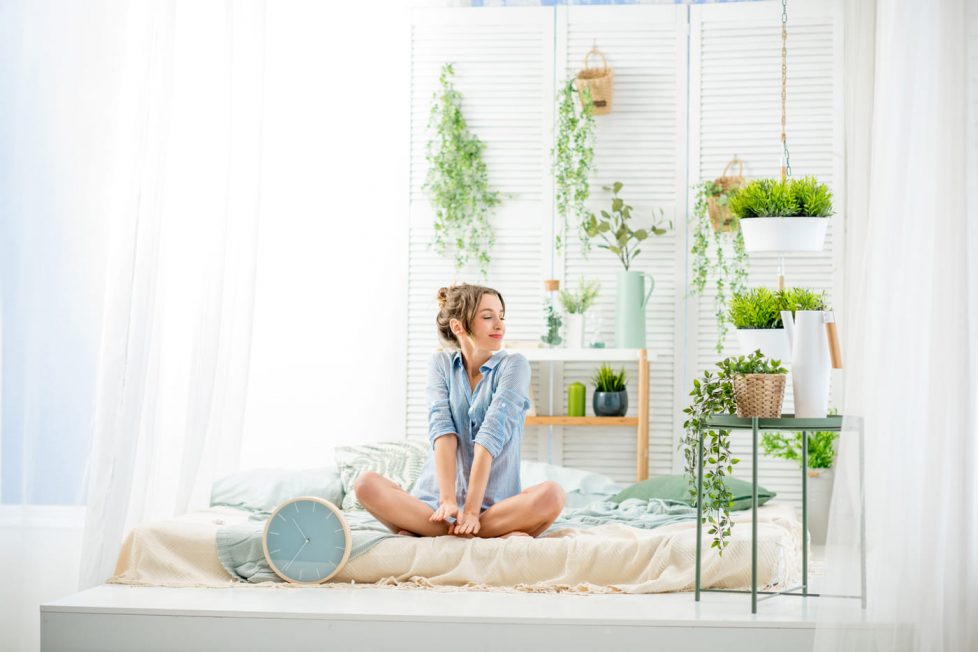Best plants to have in the bedroom

You spend a lot of time in your bedroom, so it’s important to design a space that ensures you get a good night’s rest.
One of the easiest ways to transform your bedroom into a peaceful sanctuary is with indoor plants — not only do they look beautiful, best plants for bedroom can actually help improve your health, mood and sleep quality, too. Houseplants can help bring in greenery and some sense of serenity, especially in bedrooms which are often meant to be a haven to recharge your battery. Whether your home is flooded with natural light or relies on lamps and wall sconces for illumination, best plants can thrive in your bedroom. Not only can they beautify a room, but they can also purify the air of toxins and produce nighttime oxygen, freshening the bedroom for sounder sleep.

It’s not typically thought of as a houseplant, but lavender can survive indoors under the right conditions. Along with air-purifying qualities, lavender will also bring aromatherapy benefits to the bedroom. Research shows that inhaling lavender essential oil can reduce blood pressure and heart rate. So before heading to dreamland, take a moment to smell the lavender!
The Gerber daisy (Gerbera) is an ethereal plant for most people. Don’t expect this South African native to endure a light or too little water. Think of the Gerber daisy in the same way you might think of a very long-lasting cut flower arrangement: temporary eye candy that you will eventually have to dispose of. Gerber daisies are pampered and coddled in greenhouse conditions that just can’t be replicated in a typical bedroom setting. However, it’s worth to have a plant with such perfect, vibrant blooms bring its cheer to your bedside table. While it lasts, it will even do a great job of removing trace organic pollutants from the air.4
Several different types of dracaena have been shown to clean and purify the air. They’re all easy-to-grow plants with long, strappy leaves, some of which have beautiful red markings. Whichever one you go with, know that all Dracaena species prefer similar conditions: moderate to bright indirect light, and soil that’s kept lightly moist.
This plant has flashy leaves—but the sap within contains crystals that can irritate mucous membranes. Yikes. If you have a pet that enjoys chewing on greenery, we suggest skipping it. Otherwise, it’s a generally carefree bedroom plant. Dieffenbachia only needs moderate amounts of filtered light. Keep the soil lightly moist, but never soggy.
This culinary herb has a pleasant, piney scent, particularly after you brush your fingertips against it—which we suggest doing in the morning when you get out of bed, as research shows that simply smelling this therapeutic herb can clear the mind and elevate your mood. Indoors, rosemary needs strong light, so keep it by a bright window (preferably a south-facing one).
These luxurious-looking plants are surprisingly fuss-free. The peace lily is one of the most enduring and it’s one of the best plants for a bedroom for good reason: its glossy leaves thrive in high- or low-light situations, and its roots tolerate a variety of irrigation habits. Peace lilies take the guesswork out of watering by wilting when they’re thirsty and quickly perk up with a drink of water. If your bedroom has a window, situating the peace lily nearby will increase the production of white flower-like spathes, which endure for weeks. If your room is somewhat dark and blooming seems unlikely, choose a peaceful lily variety like ‘Domino’ with its white variegated foliage to brighten up low-light environments.
Whether draping over your nightstand or from a hanging planter, English ivy is one of the best plants for the bedroom, as this trailing plant is known to release oxygen and absorb indoor air pollutants like formaldehyde and ammonia. It does best in moderate light during spring and summer months, and in bright sunlight during the fall and winter. It also appreciates humidity, so mist it often.
Aloe vera is a soothing ingredient commonly found in lotions and soaps, but it is also one of the best plants for bedroom. The tropical succulent with fleshy leaves and spiky edges doesn’t require frequent watering, but it does need bright light, so consider putting it on your bedroom windowsill.
Enter the world’s longest blooming houseplant: The neon flowers on this plant can last up to eight weeks, with fresh ones popping up regularly. Stick it in a spot with bright light and high humidity. The more light it receives, the more you should water it: As a general rule, water every week, allowing soil to dry out between waterings.
